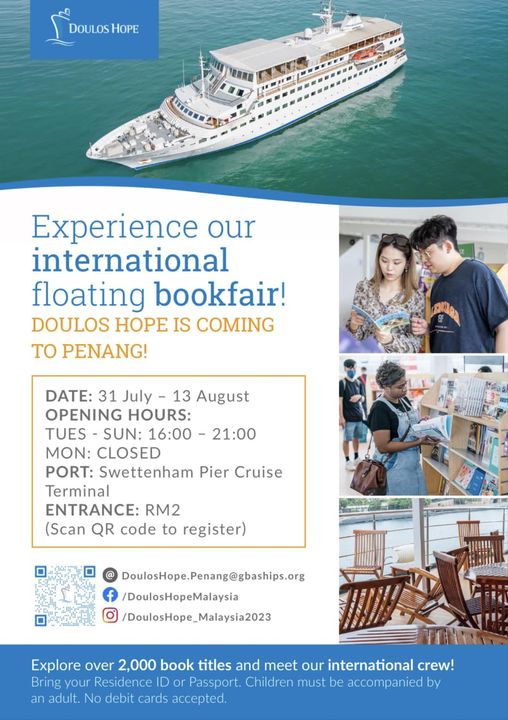"The Things They Carried" by TIm O'Brien. Usually I prefer less of fiction, but it's less of a narrative story of 'what happens next' or 'what is happening' but more of what is happening inside the minds and hearts of the characters, which is something I really like. Favourite story so far is "Speaking of Courage" which tells all the internal conflicts and struggles of someone coming back from war - real powerful and emotional read.
rom1215_
The Christians and early missionaries had indeed played a major role in public education in Malaysia, and some of the most prestigious public schools today were set up or in one way or another linked to the early Christians' works in the country. So putting religion aside, even just for sentimental reasons, it is actually quite a sad thing to see the decline or closure of mission schools today.
But fairly, this is not, or not only, at least, a fault of the government and the authorities. The past and current Christian counterparts would have to bear an equal responsibility in this decline. What people might not know is, the Church (in this case which I am personally informed, the Methodist Church in Malaysia - can't comment on other Christian denominations) does actually have a voice within the Federal Government in the matter of the public mission schools linked to the Methodist Church, e.g. MBS/MGS, ACS. And for many years, even in the days of previous leaders, the Church was given the right to nominate their own candidates for the role of the Principal in the schools. But few Christians would take up the responsibility, hence leaving the mission schools at the government's mercy in appointing whoever they want to the leadership positions - and as a result, the "Christian" identity (and influence) of the schools diminishes fast. And today, the Methodist Church is dipping their toe in private education institutes themselves and it'll be no surprise if the effort to hold on to the public schools is even lower of a priority for the Church.
And in certain Christian circles, due to one factor or another, fewer and fewer parents are inclined to send their child to public schools (missionary schools or otherwise), which while completely understandble and justified, it is for me personally quite a sad thing to see - that as Christian ourselves are not as concerned with asserting our positive influence and with contributing to the community than our forefathers were.
Perhaps a more exciting news to the professional community than to the general public, ha. But how it turns out will certainly have a direct impact on the general public, hopefully significantly positive ones in terms of better accessibility and quality of MH services.
What I'm personally interested and looking forward in particular is the emphasis on coordination and collaboration between the public and private + civil/community sector. Was very supportive of this when first raised by KJ in the previous government - hopefully this is a continuation of this initiative.
Professionally, I'm hoping for clearer and wider recognition of the counselling and psychotherapy services (non-medical) by the public health authority. Specifically, for one, for MOH to recognise referrals by licensed counsellors and clinical psychotherapists. (Right now the government hospitals only recognise referrals by medical practitioners/GPs for someone to receive treatment by specialists/psychiatrists. But in reality, counsellors and psychologists do in fact receive proper and adequate training in detecting and assessing clinical mental health conditions, and would be more than qualified to make professional judgement in making referrals for one to receive specialist/medical treatments).
Coversely, to encourage and provide a clear guidelines for psychiatrists to refer patients for psychotherapy services - especially in closer collaboration between the public and private/civil sectors. For one, psychiatrists rarely refer patients out to counsellors and psychologists to receive psychotherapy, together with or in lieu of medical treatment. But almost all mental health patients would benefit from some form of non-medical mental help, which ends up with the psychiatrists having to take up the responsibility of providing psychosocial support for the patients - which is not ideal. While I have no doubt a psychiatrist would be able to perform some rudiment form of therapy, their professional training is just not in such, compared with a counsellor or clinical psychotherapist whose core professional training is in psychotherapy, and hence a psychiatrist is not expected to be competent in handling the psychotherapy aspect of mental health treatment. Secondly, with an unbalanced ratio of psychiatrist to psychotherapist in the public healthcare service (not enough of clinical psychologists and counsellors in most healthcare facilities), most patients would miss out on the opportunity to receive a more comprehensive mental healthcare. So the aspect of collaboration is quite essential in the government's initiative - and something I'm mostly looking forward to.
For my former classmate's case it's less about academic results - we're from a quite a reputable high school after all - but more on that they were not the best behaving student in class. Though nothing bad and more of middle-schooler antics, but I remember them as quite a mischievous person, loud, and always ready for a prank. But I guess that was a way of them showcasing their leadership quality even back then.
But still it's indeed a good encouragement for young people to not base their self-value on results, also to be less anxious about their future directions, but that they'll also find their strengths and passion one day.
One of the little joys of going back home to vote - it's like a mini reunion, ha!
Also just discovered one of my former classmates was standing for election. Won by a large margin too. Never expected that, wasn't the best student in school, ha! But really glad for them, looking up some news and they seemed to be doing quite some work in their area.
Hey, some good news! Doulos Hope will be extending their stay in Penang for another 2 weeks, and the booking has just opened, so should have quite some slots still.
Yeah unfortunately the slots are extremely limited this time, apparently the only allow 200 visitors per hour slot so I have many friends who also failed to get a pass. Didn't get to visit them myself. I have some friends who signed up as volunteers though so did hear them sharing about the experience.
Imo they did suffer a bit from some bad planning and communication. They were planning to visit Penang much earlier but was delayed, while the delay was not their fault the subsequent communications were not really done well, many people were unaware of their latest schedule and by the time we got to know about their visit most of the slots were already been taken up by those who got the news earlier. Quite unfair like this la haha.
Sorry that you didn't get to visit them this time. Maybe next time (hopefully with better management haha!)
Glad you enjoyed the story and learned something interesting!
Thanks! Yeah it's so interesting isn't it? I love these kind of stories too haha. I first heard about the story from a friend, but did went on to look for more information and compiled the information I could find, and came up with this post.
Haha, hey!!! X2
But the taste is not actually the same or even similar. But the main ingredients and way of preparing have a lot of similarities, hence the inferred influence.
Thanks! I was really interested when I first heard of the story as well, and thought I must look more into it and share the story!



Just finished No Easy Day by Mark Owens, the autobiography of a Navy Seal who took part in the operation to hunt down and kill bin Laden. Interesting to read about the account if nothing else.
Also just realised this is my fourth consecutive book about war. Going to do something different next. Maybe some recommendations?